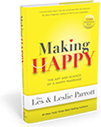We like to pretend that we can control what happens. We think if we just live a healthy lifestyle, sickness won’t intrude. Or if we follow all the “rules” of relationships, divorce won’t be an option.
But we can’t control our circumstances, no matter how good we are, no matter how many rules we follow. Bad things happen, and when someone you love leaves, either by choice or by death, it shatters the illusion of control.
When I first heard people describe grief as a journey, I thought they meant it happened step- by-step. And it does, in a way. But the journey of processing loss is more than just a physical or mental process. It’s a deep dive into the soul. It forces us to confront what we believe about the most existential questions in life: Is God really good? How can life be so fragile and terrifying? Why did this happen to me and not others?
More than likely, you will have to help your spouse, kids, and stepkids work through their pain. They will need your understanding and grace as you all move through the next few years of blending the family.
That’s why I put together a list of common myths that affect blended families. Some were myths that others had, and some were my own. Maybe you have some of them too.
Myth #1: Grief eventually ends
Grief doesn’t simply go away. Instead, the individual simply learns how to live life a new way, like a person who loses a limb learns how to adapt.
For stepfamilies after divorce, the loss is just as profound. Not only does a child of divorce miss the absent parent, the child might wonder if he somehow caused the split. He might experience bad dreams and long for the parent who is no longer in the home.
When a girl grows up, she might face choosing between her dad and stepdad to walk her down the aisle. Instead of simply enjoying the celebration, she has to worry about hurting someone’s feelings.
These losses and worries can last a lifetime. That’s why demonstrating grace and mercy is so important in stepfamilies. Everyone needs the time and space necessary to work through the sadness that inevitably comes with a broken and blended home.
Myth #2: Everyone processes emotion the same way
Because working through grief is often described as going through “stages,” many people believe that grief is predictable and orderly. After all, the word stages implies that a person just needs to accomplish certain steps, at which point he or she will be cured or “over it.”
Grief is neither predictable nor orderly
Unfortunately, the word stages is a misnomer. Grief is neither predictable nor orderly. The five so-called stages of grief—denial, anger, bargaining, depression, and acceptance—are really more like phases that the bereaved can move in and out of. They don’t necessarily happen in a certain order, and they can be repeated at any time.
This emotional journey can be influenced by personalities, temperaments, and experiences, as well as by outside relationships, such as the relationship with a biological father or mother, siblings, or grandparents.
When several hurting people are all living in the same house, there is a complicated grief network system going on at any given time. And it can be this way for years because no one is working through their grief at the same pace.
Whether adult or child, each individual will process grief differently. It’s important to notice the signs of certain stages and find ways to let all the members of your family express their feelings in an understanding environment.
Myth #3: Toddlers and young children don’t grieve
This was a myth that I wholeheartedly believed. I thought if I could (re)marry quickly and get my children into a family with a good father, they wouldn’t be affected by grief. Nothing could be further from the truth.
It’s vital that parents pay attention to the fears and worries of their children. After all, even many adults don’t understand the emotional complexity and deceptive nature of grief, especially in a blended family. It’s natural for children to see the unrest that comes with being part of a blended family and blame it on what they think is the seemingly obvious problem—the new parent.
This is a job for the child’s biological parent. Only the biological parent can assure his or her children that the new stepparent is not the problem. The problem is the problem—blending a new family is hard and it’s okay to be sad sometimes. God will work everything out in His time, even when it seems like things might never get better. Our children need to hear that they can trust God, even when they are sad.
Especially when they are sad.
Myth #4: A new parent will help fix things
Some single parents believe that if they get a new spouse to take on the vacant role of mother or father in a child’s life, then many of the child’s problems will be resolved. Indeed, I’ve spoken with many stepmoms who married a man whose wife was either deceased or not part of her children’s lives. And many of these women were heartbroken that the man’s children wouldn’t accept their mothering love.
This is a critical reality that stepfamilies need to recognize: No one else can replace a biological parent in a blended family. Especially if a child is old enough to remember the other parent, a new stepparent should not try to take over for the “missing” parent.
Consider how you might feel as an adult if your own mother or father died right now, and someone else—perhaps a virtual stranger—moved in and expected you to treat them the same way you treated your mother or father. Maybe that new person even pushed you to use the term mother or father. What’s more, you’re supposed to hug and kiss and offer your complete loyalty to this person.
Sounds ridiculous, doesn’t it? Who would expect an adult to do that? So why do we expect children to push their parent aside, even if that parent is deceased, and embrace someone new with the same love and affection?
It’s important for stepparents to know that a child doesn’t need a replacement for a parent, but they do need a male or female adult role model in their life. Perhaps as a mentor, and definitely as a supporter. That’s the place for a stepparent.
Even if both of the child’s biological parents are alive and well, all children need adult figures to serve as examples of a godly lifestyle. They need to know what to look for in a future spouse. They need both masculine and feminine perspectives on situations and decisions. A stepparent does have a role, but that role is not to replace the biological parent.
Myth #5: You can’t be happy and sad at the same time
Our culture isn’t comfortable with sadness. There are still stigmas around the idea of crying, such as these:
- It’s seen as evidence of weakness.
- It “brings others down.”
- It’s a signal that something is wrong.
Maybe there is a negative view of sadness based on the idea that if a person is sad, they can’t be happy. But thankfully that’s not true. Humans are complex creatures, able to experience conflicting emotions at the same time.
That’s how life is for many blended families. Our feelings will toggle between the joy of God’s blessings and the sadness of separation caused by death or divorce. Perhaps Solomon said it best: “For everything there is a season, and a time for every matter under heaven . . . a time to weep, and a time to laugh; a time to mourn, and a time to dance” (Ecclesiastes 3:1, 4). When we’re feeling sad, we should let ourselves feel sad. And when we’re happy, we should let ourselves be happy—even when we’re feeling sad at the same time.
Get the Book
Taken from A Home Built from Love and Loss: Coming Together as a Blended Family by Sabrina McDonald Copyright © 2024. Used by permission of Focus On the Family. All rights reserved. Represented by Tyndale House Publishers, Inc.
Sabrina McDonald is the author of A Home Built from Love and Loss: Coming Together as a Blended Family. Sabrina writes for FamilyLife on topics such as marriage, parenting, grief, and spiritual growth and has written blended-family articles for Focus on the Family publications. Sabrina speaks women’s events, churches, and podcasts. She has a bachelor’s degree in journalism and a master’s degree in marriage and family therapy from Liberty University. She’s a certified life coach and a certified “Prepare and Enrich” facilitator. She regularly posts articles and resources at SabrinaMcdonald.com.












